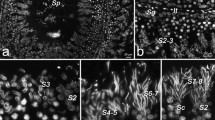Summary
H-Y (male-specific) antigen has been detected on the plasma membranes of both caput and caudal ram spermatozoa using both immunoperoxidase and immunofluorescence labelling techniques. In these spermatozoa the distribution of H-Y antigen appears to be confined to both the posterior region of the head and the mid-piece region of the flagellum. In addition, caput spermatozoa also exhibit intense immunoperoxidase staining of the cytoplasmic droplet which is situated on the flagellum at the base of the head. Western blot analyses of purified plasma membranes from the flagella of caudal spermatozoa have revealed the presence of a malespecific protein with an estimated molecular weight of 25,000–27,000.
Similar content being viewed by others
References
Bellvé AR, O'Brian DA (1983) The mammalian spermatozoon: structure and temporal assembly. In: Hartmann JF (ed) Mechanism and control of animal fertilisation. Academic Press, London New York
Bennett D, Boyse EA (1973) Sex ratio in mice of progeny inseminated with sperm treated with H-Y antiserum. Nature 246:308–309
Bradley MP, Forrester IT (1980) A [Ca2++Mg2+]-ATPase and active Ca2+ transport in the plasma membranes isolated from ram sperm flagella. Cell Calcium 1:381–390
Bradley MP, Heslop BF (1984) An improved urease ELISA protocol for the screening of monoclonal H-Y antibodies. Proc Univ Otago Med Sch 62:14–16
Bradley MP, Heslop BF (1985a) Elicitation of a rapid and transient antibody response to H-Y antigen by intrasplenic immunisation. Transplantation 39:643–648
Bradley MP, Heslop BF (1985b) A biochemical and immunological approach to the identification of H-Y antigenic proteins secreted from Daudi cells. Hum Genet 71:117–121
Brunner M, Moreira-Filho CA, Wachtel G, Wachtel S (1984) On the secretion of H-Y antigen. Cell 37:615–619
Burgoyne PS, Levy ER, McLaren A (1986) Spermatogenic failure in male mice lacking H-Y antigen. Nature 320:170–172
Goldberg EH, Boyse EH, Bennett D, Scheid M, Carswell EE (1971) Serological demonstration of H-Y (male) antigen on mouse sperm. Nature 232:478–480
Gore-Langton RE, Tung PS, Fritz IB (1983) The absence of specific interactions of Sertoli-cell-secreted proteins with antibodies against H-Y antigen. Cell 32:289–301
Hall JL, Buskin Y, Wachtel SS (1981) Immunoprecipitation of human H-Y antigen. Hum Genet 58:34–36
Hausman SJ, Palm J (1973) Serologic detection of a male-specific membrane antigen in the rat. Transplant Proc 5:307–310
Koo G, Stackpole C, Boyse E, Hammerling U, Lardis MP (1973) Topographical location of H-Y antigen on mouse spermatozoa by immunoelectron microscopy. Proc Natl Acad Sci USA 70:1502–1505
Koo G, Mittl LR, Goldberg GL (1979) Expression of H-Y antigen during spermatogenesis. Immunogenetics 9:293–296
Laemmli UK (1970) Cleavage of structural proteins during assembly of the head of bacteriophage T4. Nature 227:680–685
Lafferty ARA, Bradley MP, Heslop BF (1985) The capacity of female rats to produce antibody reactive with Daudi antigen in relation to their ability to reject H-Y incompatible skin grafts. Proc Univ Otago Med Sch 63:42–43
Meistrich ML (1972) Separation of mouse spermatogenic cells by velocity sedimentation. J Cell Physiol 80:299–312
Melvold RW, Kohn HI, Yerganian G, Fawcett DW (1977) Evidence suggesting the existence of two H-Y antigens in the mouse. Immunogenetics 5:33–41
Mollison PL (1979) Blood transfusion in clinical medicine, 6th edn. Blackwell, Oxford
Muller U, Aschmoneit I, Zenzes MT, Wolf U (1978a) Binding studies of H-Y antigen in rat tissues. Hum Genet 43:151–157
Muller U, Siebers JW, Zenzes MT, Wolf U (1978b) The testis as a secretory organ for H-Y antigen. Hum Genet 45:209–213
Nagai Y, Iwata H, Stapleton DD, Smith RC, Ohno S (1980) Testis organising H-Y antigen of man may lose its receptor-binding activity while retaining antigenic determinants. In: Steinberger A, Steinberger E (eds) Testicular development, structure and function. Raven Press, New York
Sumner AT, Robinson J, Evans HJ (1971) Distinguishing between X, Y and YY bearing human spermatozoa by fluorescence and DNA content. Nature 229:231–233
Towbin H, Staehelin T, Gordon J (1979) Electrophoretic transfer of proteins from polyacylamide gels to nitrocellulose sheets: a procedure and some applications. Proc Natl Acad Sci USA 76:4350–4354
Wiberg U (1985) H-Y transplantation antigen in human XO females. Hum Genet 69:15–18
Wiberg U, Fredga K (1985) The H-Y transplantation antigen is present in XO and X*X female wood lemmings (Myopus schisticolor). Immunogenetics 22:495–501
Zaborski P (1979) Detection of H-Y antigen on mouse sperm by the use of Staphylococcus aureus. Transplantation 27:348–350
Zenzes MT, Muller U, Aschmoneit I, Wolf U (1978) Studies on H-Y antigen in different cell fractions of the testis during pubescence. Hum Genet 45:297–303
Author information
Authors and Affiliations
Rights and permissions
About this article
Cite this article
Bradley, M.P., Forrester, I.T. & Heslop, B.F. Identification of a male-specific (H-Y) antigen on the flagellar plasma membrane of ram epididymal spermatozoa. Hum Genet 75, 362–367 (1987). https://doi.org/10.1007/BF00284109
Received:
Revised:
Issue Date:
DOI: https://doi.org/10.1007/BF00284109




